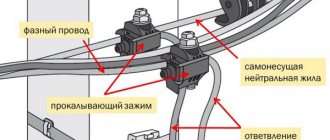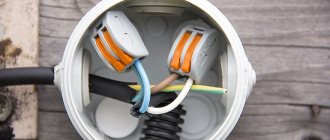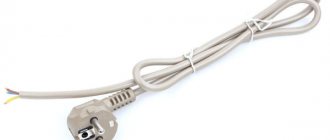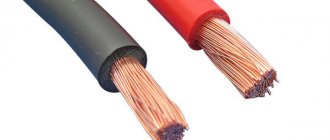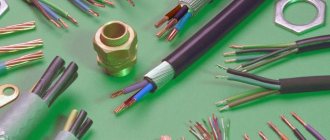Today, no home can be imagined without electrical wiring. Wires supply voltage to a variety of electrical devices that provide us with a comfortable existence.
At the same time, the number of devices may change: sometimes it is necessary to create new connection points, and for them to make new branches to supply energy.
Is it possible to create new branches in electrical wiring without cutting the wires or twisting the wires? We will talk about this in our article.
Rules for connecting wires
To connect the desired conductor to the main electrical cable, you must first disassemble the clamp. To do this, you need to remove the retaining rings located on the sides of the “nut”. After this, the bolts connecting the dies and the plate between them are unscrewed.
Then it is necessary to remove the insulation from the cable in accordance with the length of the intermediate plate inside the clamp. It is no longer advisable to strip the insulation.
How to connect the wires further? Very simple! The exposed sections of the conductors are inserted into the grooves of the dies, and then tightened with screws. Now the resulting structure is placed back into the insulated polycarbonate body of the “nut”. You will notice that there are four holes in the case. The first hole is tightly sealed, the second is intended for a branch cable, and the main electrical conductor is pulled through the remaining two holes. This is how electrical cables are connected using a nut.
Do not forget that a “walnut” type connection is not able to guarantee the tightness of all joints, therefore, during operation under different climatic and weather conditions, dust, dirt and moisture can get inside the case. To provide some degree of protection, the compression housing must be insulated or, in other words, simply wrapped with electrical tape.
Finally, we recommend watching a video that clearly shows how to connect wires using a nut clamp:
Now you know what an electric nut for connecting wires is, what its design and purpose are. We hope the information provided was useful and interesting for you!
It will be interesting to read:
Spring clamps for connecting wires
One of the most controversial ways to connect wires is using spring clamps. There are several types, but the two most common are wago terminal blocks and PPE caps. Externally and in terms of installation method, they are very different, but both designs are based on a spring, which creates strong contact with the wire.
There is controversy about this spring. Opponents of using wago say that the spring will weaken over time, the contact will become worse, the connection will begin to heat up more and more, which, again, leads to an even more rapid decrease in the degree of elasticity of the spring. After some time, the temperature may rise so much that the body (plastic) will melt, but what can happen next is known.
Spring clamps for electrical wiring - popular connections for wires
In defense of using spring clamps to connect wires, if they are used according to manufacturers' recommendations, problems are very, very rare. Although there are many fakes of both wago and PPE, as well as a sufficient number of photographs of them in melted form. But, at the same time, many people use them, and, under normal operating conditions, they work for years without complaints.
wago wire clamps
They appeared on our market several years ago and made a lot of noise: with their help, the connection is very quick and easy, and at the same time has high reliability. The manufacturer has specific recommendations for using this product:
- wago should only be used for single-core or stranded conductors with a cross-section from 0.5 mm2 to 4 mm2;
- to fix and connect stranded and small-diameter wires, use the CAGE CLAMP - from 0.08 mm2 to 35 mm2;
What's inside wago wire clamps
Inside these devices there is a metal plate, which ensures the proper degree of contact. The shape and its parameters of the plates were specially developed and tested. The tests were carried out on a vibration stand for many hours, then heated and cooled. After which the electrical parameters of the connection were checked. All tests were passed “excellent” and branded products always perform “five”.
In general, the range of Wago products is very wide, but for installing electrical wiring or connecting home appliances and lighting fixtures, two types of wire clamps are used: series 222 (detachable) with the ability to reconnect or change the connection, and series 773 and 273 - which are called permanent.
Detachable
Spring clamps for electrical wiring Wago 222 series have a certain number of contact pads - from two to five - and the same number of locking flags. Before starting the connection, the flags are raised up, the conductors stripped of insulation are inserted into them (all the way), after which the flag is lowered. At this point the connection is considered complete.
Wago wire connectors - connection methods
If necessary, you can reconnect the connection - lift the locking flag and remove the conductor. Convenient, fast and reliable.
Wago 222 series range
The 222 Vago series can be used to connect two or three, even five conductors made of copper or aluminum (you can connect different metals in one terminal). Wires can be single-core or multi-core, but with rigid wires. The maximum cross-section is 2.5 mm2. Soft stranded wires can be connected with a cross-section from 0.08 mm2 to 4 mm2.
One-piece
There is another type of clamps that does not provide the ability to redo the connection of wires - series 773 and 273. When using these terminals, the work is generally done in seconds: the stripped wire is inserted into the appropriate socket. The spring present there clamps it, ensuring contact with the plate. All.
wago contact terminals
These spring loaded wire clamps can be used to connect solid aluminum or copper wires with cross-sectional area from 0.75 mm2 to 2.5 mm2, stranded wires with rigid wires from 1.5 mm2 to 2.5 mm2. Soft stranded conductors cannot be connected using such connectors.
Types of mounting terminals for wago wiring
To improve contact, the wires must be cleaned of oxide film before connecting. To prevent oxidation from continuing, wago manufacturers also produce contact paste. The inside of the clamp is filled with it and it itself corrodes the oxide film, and then protects the wires from oxidation in the future. In this case, only heavily oxidized, dark conductors need preliminary stripping, and the clamp body is filled with paste.
By the way, manufacturers say that, if desired, the wire can be pulled out of the clamp. To do this, grab the wire with one hand, hold the terminal box with the other and rotate them back and forth with a small range, in opposite directions, stretching them in different directions.
Clamps for lamps (construction and installation terminals for lamps)
For quick and convenient connection of lamps or sconces, wago has special 224 series terminals. With their help, you can connect aluminum or copper wires of different sections and types (single-core or stranded with rigid wires). The rated voltage of this connection is 400 V, rated current:
- for copper conductors - 24 A
- 16 A for aluminum.
Cross-section of connected conductors from the mounting side:
- copper 1.0 ÷ 2.5 mm2 – single-core;
- aluminum 2.5 mm2 – single-core.
Cross-section of connected conductors on the side of the chandelier/sconce: copper 0.5 ÷ 2.5 mm2 – single-core, stranded, tinned, crimped.
When connecting aluminum wires, it is necessary to use contact paste, and copper wires must be stripped by hand to bare metal.
This product has two disadvantages. The first is that the price of original terminals is high. Secondly, there are a lot of fakes at a lower price, but their quality is much lower and they burn and melt. Therefore, despite the high cost, it is better to buy original products.
PPE caps
PPE caps (which stands for “connector insulating clips”) are very easy to use devices. This is a plastic case, inside of which there is a spring that has a conical shape. The conductors, stripped of insulation, are inserted into the cap, and the cap is turned clockwise several times. You will feel that it has stopped scrolling, which means the connection is ready.
How to make a wire connection using PPE
These conductor connectors are produced by many manufacturers; they are available in different sizes, for different diameters and the number of connected conductors. In order for the wire connection to be reliable, the size must be selected correctly, and for this you need to understand the markings.
After the letters PPE there are several numbers. Depending on the manufacturer, the number of numbers varies, but they mean the same things. For example, there is this type of marking: SIZ-1 1.5-3.5 or SIZ-2 4.5-12. In this case, the number immediately following the letters indicates the type of case. “1” is set if the body is a regular cone, on the surface of which grooves can be applied for better grip. If there is a SIZ-2, then there are small protrusions on the body that are convenient to grasp with your fingers and twist.
All other numbers reflect the total cross-section of all conductors that can be connected using this particular PPE cap.
An example of marking of PPE caps and its explanation
For example, PPE-1 2.0-4.0. This means that the body of the connecting cap is ordinary, cone-shaped. With its help, you can connect two conductors with a cross section of at least 0.5 mm2 (in total they give 1 mm, which meets the minimum requirements - see the table). This cap contains a maximum of conductors whose total cross-section should not exceed 4 mm2.
Connecting wires using PPE caps
In the second version of marking, after the abbreviation PPE there is only a number from 1 to 5. In this case, you just need to remember which of them is useful for which cross-section of wires. The data is in another table.
PPE caps and their parameters
By the way, only copper wires can be connected with PPE caps - aluminum wires, as a rule, are thicker than the maximum allowable for these connectors.
Squeeze the nut, as an option, branch the wire
And so, if we talk about this option of connecting and branching wires and cables, it is considered optimal. I decided to put him first. The nut squeeze is a simple design, see photo:
It is small in size and has a simple operating principle. I don’t even see the point in making instructions about this. This is what it looks like in cross section:
To make a branch of copper or aluminum wires in this way, you only need to put all the wires in their places. Next, we clamp everything and tighten the body. This method can be called the simplest and most effective. Plus, the cost of squeezing a nut is quite low
Pay attention to the article: how to connect wires
This is interesting: Measuring insulation resistance with a megaohmmeter: technique
Branch clamp "walnut" type
When carrying out electrical installation work that is associated with the commissioning of new electrical equipment or laying electrical wiring, there is a need to connect a cable line extending from the main cable. To make a branch from the main cable, special devices are used - branch clamps, which are also known as “cable nuts”. They are widely used when installing electrical networks for household and industrial purposes, connecting lighting equipment, etc.
As an electrician, I often have to deal with the problem of lack of voltage. And it must be said that 60% of the consumer’s lack of voltage problems are due precisely to poor contact in panels, distribution boxes and other power points.
Of course, an important fact in all these problems is that over the last half century the electrical load of household consumers has increased sharply. Each home has water heaters, electric kettles, hobs, washing machines and other powerful equipment. We try to make our environment as comfortable and cozy as possible.
Compared to the last century, when twisting was used almost everywhere, today there are many known methods for high-quality connection of electrical wires: various self-clamping and screw terminal blocks, crimping wires with sleeves. soldering, welding.
If we consider the topic of connecting wires, we cannot but ignore one very practical way of connecting wires using nut-type clamps.
Using piercing compressors
Walnut-type clamps are very convenient to use, but today you can find improved versions of them.
Piercing clamps are used once, but you don't have to strip the wires you need or subject the wires to unnecessary processing before making the connection.
It has a head with six sides, thanks to which the wires are pulled together. In addition, it has plates with teeth, thanks to which wires are pierced.
Such connections can be found in lines of self-supporting insulated wire, where it is very difficult to relieve the voltage.
The following are the advantages of how to make this type of connection:
- The plates in the clamp are insulated. Thanks to this, you can even use them on live wires, because the danger of electric shock is extremely low.
- The product has good tightness. This clamp is protected from moisture and other damage caused by weather conditions.
- These clamps last a long time and can be used even by a novice electrician.
- They are inexpensive.
- Can make wire connections from different materials, such as copper and aluminum conductors.
The biggest disadvantage of the connector is that it can only be used to make contact once. Typically, specialists do not pay attention to this, since the part is installed with a long service life in mind.
Terminal block DKS
A more outdated method of branching a wire is to use DKS terminal blocks. It is not recommended to use compact terminal blocks, because... in this case, it is impossible to do without cutting and tearing the main core. In addition, the terminal block also has such disadvantages as poor sealing and the need to periodically tighten the clamping screw, especially if the conductor is aluminum. As a result, you do not get any important advantages when splicing and at the same time you get several serious disadvantages.
Terminal Blocks Overview
Using Terminal Blocks
The use of these elements is considered obsolete. If the terminal blocks are too small, you will have to adjust the conductors to fit them, strip the wires, or make other changes.
In addition, this method of making branches has a number of disadvantages. For example, the terminals are not protected from moisture, and their clamping type sometimes needs to be tightened.
There are more disadvantages to using this element than advantages. However, you still use terminals to create a new line in electrical wiring.
Electrical connecting nuts
Welcome, friends, to my website “Electrician in the House”. The next article that I would like to publish will be devoted to electrical contact in terms of branching and connecting wires. I've been paying a lot of attention to the topics of connecting wires, but this time we'll look at nut-type connecting clamps. At first glance, the expression “nut” may give a negative impression, but this is a very simple and reliable device. A little later it will become clear why they call him that.
In my practice, I quite often encounter options for connecting wires using nut-type branch clamps.
They are often used if it is necessary to make a branch from the main wire without breaking the main line. An example of this is the diagram of a floor distribution panel. The fact is that in apartment buildings, electricity is supplied to the apartments by a branch from the main main line.
I'll try to explain. For example, there is a nine-story building. Each floor has its own switchboard. From the first floor to the last, a cable line passes through each panel - three phases and zero (TN-C system). This is in old houses, but in new houses, in addition to phase wires and the working zero, they also lay grounding with a separate wire (the result is a five-wire TN-CS system).
In the shield from this cable there is a power supply to each apartment. But in order to ensure reliable power supply for all consumers in the house, the main line is not broken at each floor, but runs as a single wire. And power is supplied to the apartments using the branch method, precisely with the help of such branch compressors of the “walnut” type.
If you do the opposite, for example, break all four wires in the switchboard on each floor and connect them to some terminal block, then in this case the reliability of power supply for all consumers in the house will sharply deteriorate. For example, if contact in one phase on the second floor is lost, the apartments on the top seven floors of the building that are connected to this phase will remain without voltage. And no one needs this.
conclusions
Thus, we have considered all the currently existing methods of connecting wires in a junction box. In order to understand which method will be better, you need to decide under what conditions the wiring will be operated and what load will be placed on it. If you calculate in detail all the parameters of the electrical network in a house or apartment, then all the work can be done with your own hands. Most connecting elements are available for sale in specialized stores or in the hypermarket in the Electricity department.
However, it is worth noting that working with electricity is a responsible task. According to regulations, only a qualified specialist can perform electrical installation work.
In addition, to perform some types of connections (for example, welding), you need to have the appropriate equipment and tools on hand.
Based on the above, it is recommended to contact specialists for help. Do not save money on the safety of your family and home. Proceed with independent electrical work only if you have certain knowledge in this area and confidence in your own abilities.
Methods for connecting aluminum and copper wires
There are many situations in which there is an urgent need to organize such connections. And it is not always possible to quickly and easily replace old aluminum wiring in a house with new copper wiring. If, when trying to connect new electrical equipment, it turns out that the wiring in the house is aluminum, then be sure to use one of the available connectors.
We list the main types of electrical connectors for different conductors:
Terminal block (terminal block)
These devices deserve a separate article for consideration, but for now let us draw your attention to the main nuances of their operation. For reliable contact of aluminum and copper conductors in a screw or self-clamping type device, it is necessary to make plates from neutral materials
Alternatively, their surface should be coated with a special paste made exclusively for such actions. This information must be indicated on the label or in the instructions for the product. "Nuts." We wrote about them above. The products got their name due to their structure: the role of the shell is played by a plastic body made of carbolite, the filling is played by clamping plates for good contact. You can use branch clamps without any problems. To begin with, the aluminum conductor line is stripped at the commutation point, after which it is placed in the channel of one of the clamping plates. The copper core of the new equipment is installed in another plate without contact with the external channel. Products with a cross section of 120-150 sq. mm are used mainly by professional electricians, 1.5-4 sq. mm - at home. The piercing clamp is connected directly to the self-supporting insulated wire (SIP) on the main line. It is best to entrust the implementation of such branches to qualified specialists. If you decide to do this yourself, then the device should be connected to the conductors without breaking the insulation (without stripping the cable). Tighten the nut firmly, which will pierce and ensure contact. A homemade connector can be made from one bolt, three brass washers, a nut and electrical tape. To connect aluminum and copper conductors, the area of their direct contact is separated by three washers. This method is considered a temporary connection, but in fact the node will last for several decades.
This is interesting: Calculation of grounding for a private house - formulas, diagrams, videos
How to connect aluminum and copper conductors
By the way, let us remind you why you cannot directly connect copper and aluminum wires. There are two reasons:
- This connection gets very hot, which in itself is very bad.
- Over time, the contact weakens. This happens because aluminum has a lower electrical conductivity than copper, and as a result, when the same currents pass through, it heats up more. When heated, it expands more, squeezing out the copper conductor - the connection becomes worse and gets hotter.
To avoid such troubles, copper and aluminum conductors are connected using:
- terminal blocks;
- wago;
- bolted connection;
- branch clamps (make connections of wires on the street).
Other types of connectors cannot be used.
Application example
Clamps are considered low-voltage components and operate in the voltage range from 60 to 660 V. Installation inside electrical panels, when laying open electrical wiring and connecting low-power devices, is acceptable.
The installation process is as simple as possible. After selecting the desired model in accordance with the cross-section of the conductors to be fastened, remove the clamping plates from the equipment. To do this, remove the fastener holding the two parts of the case together. The fastening design can be different: using a locking ring, a threaded element with self-tapping screws or a washer holding the halves of the “shell” together.
After removing the clamping plates, depending on their size, the length of the section where the insulation on the switched cable will be removed is calculated. You can leave the corresponding marks with a marker or pen. Using a sharpened knife, cut the insulation as carefully as possible without touching the wires, and then remove it from the wire.
It is best to wipe the clamping surfaces and stripped wires with a cotton swab and any degreaser. Install the conductors into the recesses of the die. Adding a conductive lubricant is a great idea. Connect and fasten the parts by tightening the screws tightly. Hide the clamping plates inside the housing, holding both halves securely together. To ensure a stable connection, place Grover washers under the screws on the die.
Connecting wires with a terminal block
When choosing a connecting block, you should first of all take into account the amount of current that will pass through the connection point, as well as the required number of mounting terminals in the comb. As a rule, the process of connecting conductors does not cause any difficulties even for amateur electricians.
Installation is really very simple: take a block with the required cell size, cut off the required number of sections, insert the cores inside the terminal cell and use screws to clamp each of the connected conductors.
The core fixing screws should be tightened with fairly moderate force. Naturally, the insulation should first be removed from the ends of the connected conductors (it is quite enough to remove about 5 mm of insulation), and the surface of the conductor itself should be thoroughly cleaned.
The big advantage of such blocks is that, depending on the installation conditions, each segment can be cut off. However, there is one nuance here: I would not recommend clamping aluminum in such a block. When tightening, the aluminum core can be pressed by the screw itself.
If aluminum conductors are connected, the screws must be tightened with extreme care. This is due to the fact that, firstly, the aluminum core can simply break, and, secondly, as is known, aluminum has a certain fluidity under the influence of significant pressure, which after some time can lead to deterioration or complete loss of contact.
And this, in turn, is fraught with overheating of the conductor and its fire. By the way, according to the standards, absolutely all connections that contain aluminum must be tightened once a year.
Application example
Consider a multi-storey building consisting of seven floors. As you know, it is customary to place switchboards at the entrance on each floor. Starting from the bottom floor to the top, a four- or five-core cable is installed (in new houses with modern wiring, where there is a separate grounding conductor). It passes through all the panels on the floors. Each panel supplies the apartments with power. In this situation, the use of a nut-type connector is simply absolutely necessary in order to ensure the connection of the electrical wires on each floor with a common main cable without breaking it on each individual floor.
If in this situation you break the “backbone” on all floors, connecting it to terminal blocks. this will significantly reduce the level of reliability of power supply to consumers. That is, if there is no contact on one of the phases for consumers on the lower floors, consumers on all upper floors, which, in turn, are connected to this phase, then risk being left without voltage.
Connecting wires (cables) to car wiring using connectors, twists, clamps
When installing additional electrical equipment, the car enthusiast is always faced with the question of how to connect, connect wires, or rather, cables to each other in the car. Conventional strands have their drawbacks, as they do not guarantee reliable contact with the constant pressing force of the conductors if you do not crimp them properly. Oddly enough, you also need to twist it correctly and be able to do it. In addition, twists in the electrical wiring of a car may not seem aesthetically pleasing and are not always convenient for installation, especially in winter, when electrical tape is used to insulate the connection. Everyone knows that the adhesive layer in this case does not provide sufficient adhesion between the materials. However, twisting cannot be written off! In addition, connections are made on clamps, when with a slight movement of the hand one wire is connected to another, and on contact blocks, when the wires are connected to each other using fasteners. Each of these options has its own advantages and disadvantages, each of them can be found on the cars of car enthusiasts. But which one to choose and how to implement the connection of wires in the car yourself, this is exactly what our article is about.
One of the options for connecting wiring in a car is to use a specialized connector. In addition to this, you will also need regular pliers.
WAGO terminal blocks
Vago terminal blocks are currently the top-end wire connectors. Although they also have their drawbacks - they are expensive and have a weak switching current. The photo below shows the operating principle of Vago terminal blocks.
At present, blue electrical tape can already be shelved. If earlier the Soviet Union was built with its help, now there is no need for it. It’s much easier to go to the nearest store and buy connectors for wires. It won't hurt your pocket too much. As a result, your electrical installation will be much stronger and safer.
Also, do not forget about the current strength for which these connectors are designed. For example, you should not use VAGO terminal blocks for various electric boilers and powerful energy consumers. In this case, they may not be able to withstand heavy loads, which will lead to even worse consequences.
Purpose, advantages and disadvantages of connectors
The main purpose of branch compression is to organize a branch on the main electrical cable without making a break on the main route. The nut connector can be installed where the trunk is installed with new equipment wiring, and there is no need to cut the cable. This is one of the best options when switching conductors of different cross-sections made of aluminum and copper. It is advisable to make the contact plate brass, since this material does not enter into an electrochemical reaction with either copper or aluminum.
Among the shortcomings, it is immediately worth noting the need to expose the connected wires. This does not need to be done when using piercing type branch clamps. Another nuance is the weak degree of protection against dust and moisture (no higher than IP20).
Clamp type OB
When repairing or replacing electrical wiring in an apartment, you can use another pretty good option for splicing wires - using OB type clamps. The products have a simple design and an equally simple operating principle - the cable is placed in a special latch, which uses a brass connector to pierce the conductor insulation layer. As a result, in a matter of seconds you can make a good branch from the main power cable (for example, to a socket).
As for the disadvantages of latches, the main one is the limited conditions of use - the cross-section of the conductors should not exceed 6 mm 2. In turn, for home electrical wiring, such a cross-section will be quite sufficient even for connecting a powerful electric stove.
Such connectors are also called “Scotchlocks”. You can learn more about what Scotchlocks are and how to use them in our separate article: https://samelectrik.ru/skotchloki-dlya-soedineniya-provodov.html.
Video instructions for using a latch to branch a wire without cutting:
Piercing clamps
An improved model of nut cable compression are piercing clamps. Disposable products, however, allow you to make a wire branch without cutting and even without peeling off the insulating layer when splicing. The design of the clamp is represented by a hexagonal head, which tightens the conductors, as well as contact plates with teeth, which actually pierce the insulating material.
The advantage of these products is as follows:
- You can branch wires from an overhead line (OHL) even under voltage, without fear for your safety. This is due to the fact that the contact plate is reliably insulated from the clamping bolts.
- The housing of the products is sealed and reliably protects the connection point from bad weather conditions.
- The clamps are easy to use and have a long service life.
- Low cost of production.
- Possibility of bonding copper and aluminum conductors.
As for the disadvantages, the main thing is only the “disposability” of the product, but this point is very controversial, given the durability of this method of branching wires without breaking.
Installation is carried out as follows:
Video instructions for installing a piercing clamp
Electrical connection blocks
A terminal block is a special electrical installation device for connecting conductors. Any block consists of a pair (or several pairs) of metal contacts with fasteners for conductors, which are located in a dielectric housing.
The polyethylene frame is designed for several cells, inside each there is a brass tube (sleeve). The ends of the connected wires must be inserted into this sleeve and clamped with two screws. It is very convenient that as many cells are cut from the block as it is necessary to connect pairs of wires, for example, in one junction box.
But not everything is so smooth, there are also disadvantages. At room conditions, aluminum begins to flow under screw pressure. You will have to periodically inspect the terminal blocks and tighten the contacts where the aluminum conductors are fixed.
If this is not done in a timely manner, the aluminum core in the terminal block will become loose, lose reliable contact, and, as a result, spark and heat up, which can result in a fire. Such problems do not arise with copper conductors, but it would not be superfluous to periodically inspect their contacts.
Terminal blocks are not intended for connecting stranded wires. If stranded wires are clamped into such connecting terminals, then when tightening the screw under pressure, the thin wires may partially break, which will lead to overheating.
In cases where it becomes necessary to clamp stranded wires into a terminal block, it is imperative to use auxiliary pin lugs.
It is very important to choose the correct diameter so that the wire does not jump out later. The stranded wire must be inserted into the lug, crimped using pliers and secured in the terminal block.
As a result of all of the above, the terminal block is an ideal option for single-core copper wires. With aluminum and stranded ones you will have to comply with a number of additional measures and requirements.
- They have a number of advantages:
- Ease of use.
- Possibility of connecting wires from dissimilar materials.
- Protection against corrosion and other external influences.
- Reliability, strength of connections.
- Terminal blocks can have different designs. The most popular are 3 types of execution:
- screw;
- spring;
- knife;
Terminals on plastic blocks
Another very convenient wire connector is a terminal on plastic blocks. This option differs from terminal blocks in that it has a smooth metal clamp. The clamping surface has a recess for the wire, so there is no pressure on the wire from the screw being tightened. Therefore, such terminals are suitable for connecting any wires.
Everything about these clamps is extremely simple. The ends of the wires are stripped and placed between the contact and pressure plates.
Such terminals are additionally equipped with a transparent plastic cover, which can be removed if necessary.
Self-clamping terminals
Wiring installation using such terminals is simple and quick.
The wire must be inserted into the hole to the very end. There it is automatically fixed using a pressure plate, which presses the wire against the tinned busbar. Thanks to the material from which the pressure plate is made, the clamping force does not weaken and is maintained all the time.
The internal tinned busbar is made in the form of a copper plate. Both copper and aluminum wires can be fixed in self-clamping terminals. These terminals are disposable.
And if you want clamps for connecting reusable wires, then use terminal blocks with levers. They lifted the lever and inserted the wire into the hole, then fixed it there by pressing it back. If necessary, the lever rises again and the wire protrudes.
Try to choose clamps from a manufacturer that has proven itself well. The clamps have especially positive characteristics and reviews.
Screw terminal blocks
Screw connectors are widely used in the electrical industry; in fact, they are a variation of a tubular (coupling) product. They are made in the form of a rectangular tube, but with a rounded (oval) bottom. On the upper plateau of such a tube there are threaded holes into which locking screws are screwed.
The entire structure is enclosed in nylon insulation. For access to the screws, passage channels are made in the insulation body. There are two types of such terminal blocks (connectors) for connecting wires - single and group.
Screw terminal blocks for connecting wires are characterized by: pronounced mechanical strength; ability to work with cables with a cross-section of up to 25 mm; use in low current and power circuits. Working with this type of connectors is easy.
The end parts of the wires are inserted inside the brass tube and the locking screws (usually two screws) are tightened with a screwdriver. In turn, the screws press the conductor to the bottom of the metal tube.
Screw terminal blocks are one of the most common types. They are a brass sleeve with two bolts in a plastic case. Contact is ensured by bolt pressure. The body can be made of different materials - polyethylene, polyamide and polypropylene. With their help, you can connect wires with cross-sections from 0.5 mm2 to 35 mm2.
- The advantages of screw pads include:
- No special tools required (only a screwdriver is needed).
- Reusable.
- Possibility of using the required number of segments.
- Screw pads also have a number of disadvantages:
- High contact resistance.
- Low reliability (weakened by vibration).
- Restrictions on wire material.
- Installation duration.
- Requires some skill to tighten.
- Annual maintenance required.
It is not advisable to use such terminals. They have increased “fluidity”; the connection weakens over time. To avoid heating due to an increase in contact resistance, it is necessary to tighten them regularly. This creates inconvenience during operation.
Certain problems also arise with multi-core wires. With screw connections, high-quality installation can only be performed using special tips or blocks with a pressure plate. Otherwise, there is a risk of damage to the cores when tightening the screw.
Thus, single-core copper wires are most suitable for this design.
- Installation with a screw connection is very simple:
- Cut off the required number of terminals from the block (with a regular knife).
- Strip the insulation of the connected wires (5-12 mm).
- Insert the stripped ends of the wires into the terminals.
- Tighten the screws.
Dealing with this is not difficult. The main thing is to be careful when tightening screws and choose quality terminal blocks.
When choosing, you need to pay special attention to the manufacturer of the product. Today there are products from different brands on sale. It is better to use products from such well-known manufacturers as Legrand, ABB, Tridonic, Werit.
Spring type terminal blocks
The most common terminal blocks of this type are self-clamping terminal blocks from WAGO.
- The WAGO series is available in 2 versions:
- PUSH WIRE (one-piece disposable).
- CAGE CLAMP (reusable).
It is impossible to remove the conductor from disposable terminals without damaging the terminal block. Reusable ones have a convenient lever to release the conductor.
This equipment is widely used not only in industrial production, but also in domestic conditions. They are especially popular for lighting networks.
The clamping occurs using a steel spring coated with a special chromium-nickel alloy. The complex shaped spring provides a reliable, durable connection. The housing, made of polycarbonate or polyamide, can withstand a wide range of temperatures and is resistant to aggressive environments.
The terminal blocks themselves are made of tinned copper. This significantly increases the contact patch, reduces contact resistance, and protects against corrosion. In addition, WAGO can be filled with a special lubricant that provides additional protection against corrosion.
Model WAGO. WAGO is capable of connecting 2-8 conductors with a diameter of 0.5-4 mm2. They are designed for a voltage of 220 V and a current of 32 A.
All spring springs come in 2 versions - for DIN rail and standard version.
DIN-rail terminal blocks are used in control panels, control cabinets, and distribution boxes. They are used wherever there is increased vibration (for example, mechanical engineering, railway industry).
Phoniexcontact produces terminal blocks for DIN rails, designed for wires both with and without lugs with a cross-section of up to 35 mm2. It is possible to connect up to 50 wires simultaneously.
The main advantage of Phoniexcontact equipment is its versatility. You can make any assemblies. All elements fit together easily.
- Installation is extremely simple and accessible:
- First you need to prepare the conductor - strip the insulation by about 10-13 mm.
- To connect the wire, just open the clamp using a regular screwdriver, insert the conductor and remove the screwdriver. The contact will close automatically.
- Advantages of spring connections:
- Availability of a separate socket for each conductor.
- Durable, high-quality connection.
- Low contact resistance.
- Possibility of joining wires from different materials.
- Protection against corrosion and other external influences.
- No special tools required.
- No special skills required.
- Possibility of reusable use.
- Does not require annual maintenance.
- Vibration resistance.
- Free access for measuring tools.
- Potential distribution (if necessary) using jumpers.
- The disadvantages include low permissible currents.
In addition to such well-known brands as WAGO, Phoniexcontact, similar equipment is produced by Legrand and ABB.
Knife Type Terminal Blocks
Such pads are used much less frequently. Mainly for grounding and grounding circuits when installed with an unbroken current-carrying conductor. They are used to cut branches into the supporting conductor.
In addition, knife joints are widely used in audio technology. Blocks are available with a width of 5 mm for conductors with a cross section of 0.2-1 mm2, and 6 mm width for conductors with a cross-section of 1-2.5 mm2. The large contact area allows you to withstand currents up to 24 A. The color range is quite varied: yellow-green, orange, gray, blue and red.
There are disposable and reusable pads. Disposable pads include Scotchlok pads produced by 3M. In them, the joining of several wires is done by pressing with a special tool.
Their main distinguishing feature is that stripping of the conductor is not required during installation. The wire along with the insulation is inserted into the terminal block and crimped until it is completely fixed. The insulation is cut through by contacts, providing a reliable permanent connection.
- Advantages of knife terminal blocks:
- Saving installation time.
- No stripping or crimping of the wire is required.
- Secure connection thanks to a lever with a latch.
- Reliability, compactness.
- No special tool required.
- No special skills required.
- Increased electrical safety.
The only disadvantage is the high price.
The products are manufactured by such well-known manufacturers as Klemsan, Legrand, 3M, and many others.


